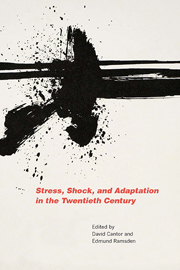15 results
Animal Ethics R Garner (2005). Published by Polity Press, 65 Bridge Street, Cambridge CB2 1UR, UK. 224 pp Paperback (ISBN 0 7456 3079 0). Price £15.99.
-
- Journal:
- Animal Welfare / Volume 15 / Issue 2 / May 2006
- Published online by Cambridge University Press:
- 11 January 2023, pp. 193-194
-
- Article
- Export citation

Stress, Shock, and Adaptation in the Twentieth Century
-
- Published by:
- Boydell & Brewer
- Published online:
- 05 April 2014
- Print publication:
- 20 February 2014
Part Two - Trauma and Acute Stress
-
- Book:
- Stress, Shock, and Adaptation in the Twentieth Century
- Published by:
- Boydell & Brewer
- Published online:
- 05 April 2014
- Print publication:
- 20 February 2014, pp 71-72
-
- Chapter
- Export citation
List of Contributors
-
- Book:
- Stress, Shock, and Adaptation in the Twentieth Century
- Published by:
- Boydell & Brewer
- Published online:
- 05 April 2014
- Print publication:
- 20 February 2014, pp 343-346
-
- Chapter
- Export citation
4 - From Primitive Fear to Civilized Stress: Sudden Unexpected Death
- from Part Two - Trauma and Acute Stress
-
-
- Book:
- Stress, Shock, and Adaptation in the Twentieth Century
- Published by:
- Boydell & Brewer
- Published online:
- 05 April 2014
- Print publication:
- 20 February 2014, pp 96-118
-
- Chapter
- Export citation
Part One - Packaging Stress
-
- Book:
- Stress, Shock, and Adaptation in the Twentieth Century
- Published by:
- Boydell & Brewer
- Published online:
- 05 April 2014
- Print publication:
- 20 February 2014, pp 19-20
-
- Chapter
- Export citation
Part Four - Work
-
- Book:
- Stress, Shock, and Adaptation in the Twentieth Century
- Published by:
- Boydell & Brewer
- Published online:
- 05 April 2014
- Print publication:
- 20 February 2014, pp 187-188
-
- Chapter
- Export citation
Part Three - War
-
- Book:
- Stress, Shock, and Adaptation in the Twentieth Century
- Published by:
- Boydell & Brewer
- Published online:
- 05 April 2014
- Print publication:
- 20 February 2014, pp 119-120
-
- Chapter
- Export citation
Part Five - Managing Stress
-
- Book:
- Stress, Shock, and Adaptation in the Twentieth Century
- Published by:
- Boydell & Brewer
- Published online:
- 05 April 2014
- Print publication:
- 20 February 2014, pp 239-240
-
- Chapter
- Export citation
Contents
-
- Book:
- Stress, Shock, and Adaptation in the Twentieth Century
- Published by:
- Boydell & Brewer
- Published online:
- 05 April 2014
- Print publication:
- 20 February 2014, pp v-vi
-
- Chapter
- Export citation
Part Six - Surveilling Stress
-
- Book:
- Stress, Shock, and Adaptation in the Twentieth Century
- Published by:
- Boydell & Brewer
- Published online:
- 05 April 2014
- Print publication:
- 20 February 2014, pp 289-290
-
- Chapter
- Export citation
Frontmatter
-
- Book:
- Stress, Shock, and Adaptation in the Twentieth Century
- Published by:
- Boydell & Brewer
- Published online:
- 05 April 2014
- Print publication:
- 20 February 2014, pp i-iv
-
- Chapter
- Export citation
Index
-
- Book:
- Stress, Shock, and Adaptation in the Twentieth Century
- Published by:
- Boydell & Brewer
- Published online:
- 05 April 2014
- Print publication:
- 20 February 2014, pp 347-367
-
- Chapter
- Export citation
Acknowledgments
-
- Book:
- Stress, Shock, and Adaptation in the Twentieth Century
- Published by:
- Boydell & Brewer
- Published online:
- 05 April 2014
- Print publication:
- 20 February 2014, pp vii-viii
-
- Chapter
- Export citation
Techniques of the Brain and the Paradox of Emotions, 1880–1930
-
- Journal:
- Science in Context / Volume 14 / Issue 4 / December 2001
- Published online by Cambridge University Press:
- 18 December 2002, pp. 643-660
- Print publication:
- December 2001
-
- Article
- Export citation

